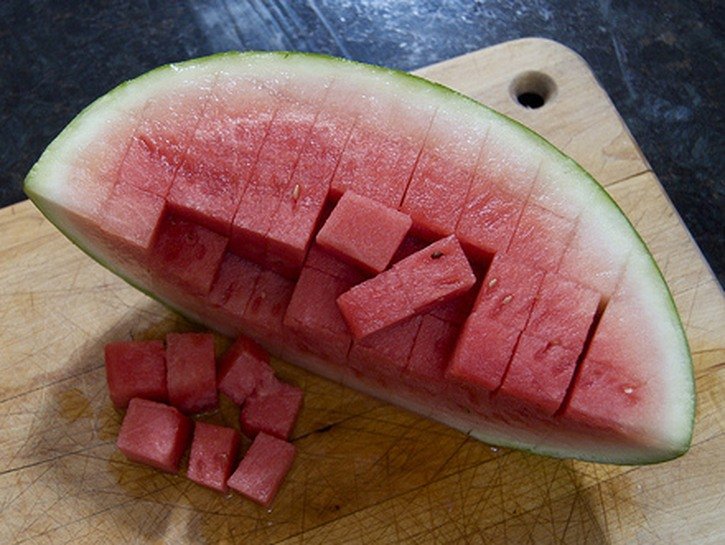Watermelons are a terrific snack for the warmer months and with the sunny weather on its way, you should refresh yourself on the best ways to choose a ripe watermelon.
It’s a bit more complicated than knocking on it at the grocery store so here are the key steps you need to follow in order to find the perfect watermelon.
What To Avoid

Though a big, honkin’ mold spot should be enough to deter you away from a watermelon like that, you should also keep an eye out for watermelons that give off a dull sound when tapped, are too mushy, are lightweight, or don’t have the proper coloring.
Check The Exterior
Watermelons are one of those fruits that you can judge by its cover. There are other fruits, like mangos, that go against the myth of fruit color relating to ripeness. But, fruits like watermelons and pineapples don’t belong to that club. If you take a look at the exterior of a watermelon you’ll be able to tell the ripeness by its dark green color.
You’ll also want to make sure that your watermelons aren’t too shiny. Its exterior should be more on the dull side and if it’s too shiny then it isn’t ripe yet.
Also, your watermelons should tick all the obvious boxes like not having any scratches or bruises on it.
Look At The Underbelly
There’s quite literally a sweet spot on the watermelon that you should look out for. This is referred to as the “field spot” because it’s the spot where the watermelon would have been resting on the ground in the fields where it was growing. This spot should be a pale yellow in color. If it’s more a green-white then you know your watermelon isn’t ripe yet.
Weigh Them In Your Hands
You don’t need any scales with this tip. All you need is some good judgment and two hands.
Pick up a few watermelons and see which one is the heaviest. According to the National Watermelon Promotion Board, they’re made up of 92% water, so the heavier the watermelon the riper it is. It should be heavier than it looks and though some people don’t consider this to be a foolproof method, it’s definitely one of the best tests you can put your watermelon through.

Smell Your Watermelons
Something else you can do is give the watermelon a smell. They do give off a sweet, healthy aroma when they’re ripe. Though, if you smell something that’s overly sweet that could be the sign of an overripe watermelon and therefore one to leave behind.
Give It A Good Squeeze
The majority of fruits will need to be given a squeeze before you purchase them. You’ll need to gently squeeze the sides of the watermelon to see if it yields to the light pressure. Much like mangos, watermelons should have a firmness to them without being rock hard and give slightly to the pressure without being mushy.
Knock On It
One of the best (and most fun) ways to determine if your watermelon is ripe is to knock on it. Learning how to determine the difference in sound can be a little tricky, though, because an overripe and underripe watermelon will each give off their own sounds too.
The sound of a ripe watermelon should resemble knocking on a door or more like a “plunk” sound. An overripe watermelon is going to sound fairly dull when you knock on it and an underripe one will sound more high-pitched in a way.
Once you start tapping on multiple watermelons you’ll be able to pick up the difference pretty quickly though.

Properly Storing Your Watermelons
When you purchase your watermelon you can keep them at room temperature for about three weeks before you cut into it. Whole watermelons aren’t kept in coolers at the supermarket and the reason why is that when watermelons are intact, they can last quite a while at room temperature without spoiling.
However, you may have noticed that watermelons in the coolers at the market are sliced or cut into chunks. The same applies to you at home. When you cut your watermelon into pieces you’ll want to wrap the pieces in plastic wrap and keep them in the fridge for up to three days. Smaller cut-up pieces also go into the fridge but they can be placed in airtight containers as opposed to being wrapped.
If you’re looking to save your watermelon for even longer, you’ll need to transfer the pieces over to a heavy duty freezer bag or an airtight container for up to six months. Some people worry that just sticking the pieces in a freezer bag or container will cause them to stick together. The way to avoid this is by freezing the watermelon pieces in a single layer on a plate or baking sheet first and wait until they go solid. Once they do, transfer them to your freezer bag or airtight container and let them sit for up to six months.
Those are all the tips you need to select a ripe watermelon and how to store them properly at home!
